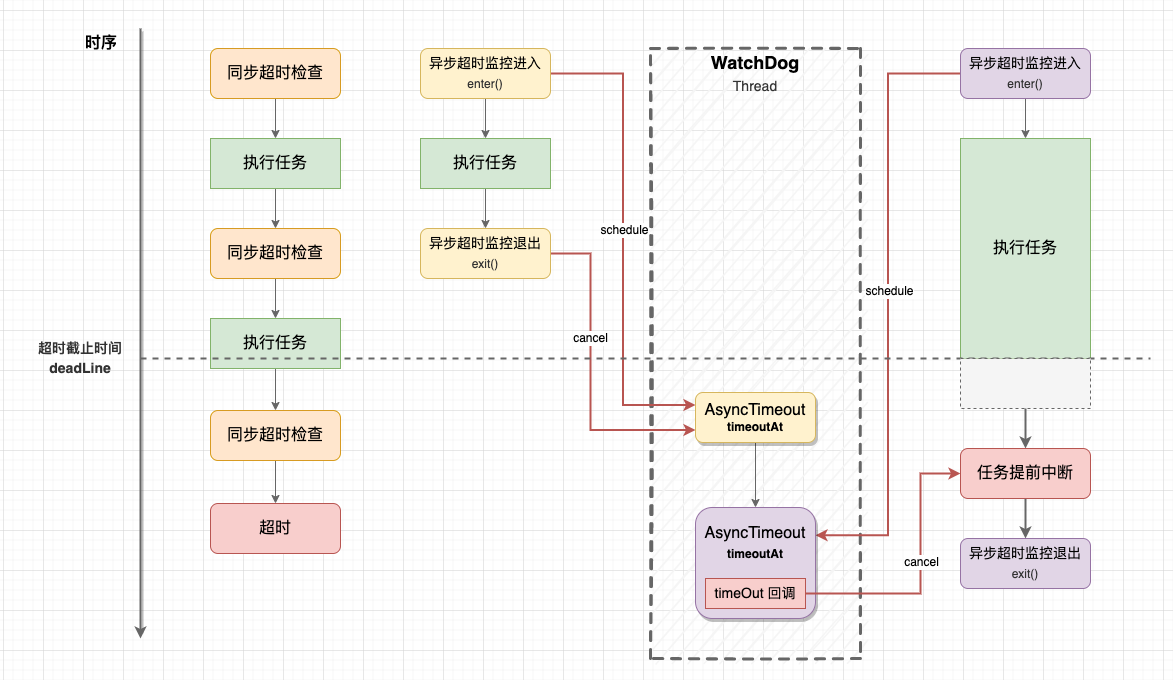本文已收录到 AndroidFamily,技术和职场问题,请关注公众号 [彭旭锐] 提问。
大家好,我是小彭。
在上一篇文章里,我们聊到了 Square 开源的 I/O 框架 Okio 的三个优势:精简且全面的 API、基于共享的缓冲区设计以及超时机制。前两个优势已经分析过了,今天我们来分析 Okio 的超时检测机制。
本文源码基于 Okio v3.2.0。
思维导图:

超时机制是一项通用的系统设计,能够避免系统长时间阻塞在某些任务上。例如网络请求在超时时间内没有响应,客户端就会提前中断请求,并提示用户某些功能不可用。
先思考一个问题,相比于传统 IO 的超时有什么优势呢?我认为主要体现在 2 个方面:
Java 原生 IO 操作是否支持超时,完全取决于底层的系统调用是否支持。例如,网络 Socket 支持通过 setSoTimeout API 设置单次 IO 操作的超时时间,而文件 IO 操作就不支持,使用原生文件 IO 就无法实现超时。
而 Okio 是统一在应用层实现超时检测,不管系统调用是否支持超时,都能提供统一的超时检测机制。
Java 原生 IO 操作只能实现对单次 IO 操作的超时检测,无法实现对包含多次 IO 操作的复合任务超时检测。例如,OkHttp 支持配置单次 connect、read 或 write 操作的超时检测,还支持对一次完整 Call 请求的超时检测,有时候单个操作没有超时,但串联起来的完整 call 却超时了。
而 Okio 超时机制和 IO 操作没有强耦合,不仅支持对 IO 操作的超时检测,还支持非 IO 操作的超时检测,所以这种复合任务的超时检测也是可以实现的。
Timeout 类是 Okio 超时机制的核心类,Okio 对 Source 输入流和 Sink 输出流都提供了超时机制,我们在构造 InputStreamSource 和 OutputStreamSink 这些流的实现类时,都需要携带 Timeout 对象:
Source.kt
interface Source : Closeable {
// 返回超时控制对象
fun timeout(): Timeout
...
}
复制Sink.kt
actual interface Sink : Closeable, Flushable {
// 返回超时控制对象
actual fun timeout(): Timeout
...
}
复制Timeout 类提供了两种配置超时时间的方式(如果两种方式同时存在的话,Timeout 会优先采用更早的截止时间):
最终触发超时的截止时间是任务的 startTime + timeoutNanos;
Timeout.kt
// hasDeadline 这个属性显得没必要
private var hasDeadline = false // 是否设置了截止时间点
private var deadlineNanoTime = 0L // 截止时间点(单位纳秒)
private var timeoutNanos = 0L // 处理单次任务的超时时间(单位纳秒)
复制创建 Source 和 Sink 对象时,都需要携带 Timeout 对象:
JvmOkio.kt
// ----------------------------------------------------------------------------
// 输入流
// ----------------------------------------------------------------------------
fun InputStream.source(): Source = InputStreamSource(this, Timeout() /*Timeout 对象*/)
// 文件输入流
fun File.source(): Source = InputStreamSource(inputStream(), Timeout.NONE)
// Socket 输入流
fun Socket.source(): Source {
val timeout = SocketAsyncTimeout(this)
val source = InputStreamSource(getInputStream(), timeout /*携带 Timeout 对象*/)
// 包装为异步超时
return timeout.source(source)
}
// ----------------------------------------------------------------------------
// 输出流
// ----------------------------------------------------------------------------
fun OutputStream.sink(): Sink = OutputStreamSink(this, Timeout() /*Timeout 对象*/)
// 文件输出流
fun File.sink(append: Boolean = false): Sink = FileOutputStream(this, append).sink()
// Socket 输出流
fun Socket.sink(): Sink {
val timeout = SocketAsyncTimeout(this)
val sink = OutputStreamSink(getOutputStream(), timeout /*携带 Timeout 对象*/)
// 包装为异步超时
return timeout.sink(sink)
}
复制在 Timeout 类的基础上,Okio 提供了 2 种超时机制:
Okio 框架

Timeout 同步超时依赖于 Timeout#throwIfReached() 方法。
同步超时在每次执行任务之前,都需要先调用 Timeout#throwIfReached() 检查当前时间是否到达超时截止时间。如果超时则会直接抛出超时异常,不会再执行任务。
JvmOkio.kt
private class InputStreamSource(
// 输入流
private val input: InputStream,
// 超时控制
private val timeout: Timeout
) : Source {
override fun read(sink: Buffer, byteCount: Long): Long {
// 1、参数校验
if (byteCount == 0L) return 0
require(byteCount >= 0) { "byteCount < 0: $byteCount" }
// 2、检查超时时间
timeout.throwIfReached()
// 3、执行输入任务(已简化)
val bytesRead = input.read(...)
return bytesRead.toLong()
}
...
}
private class OutputStreamSink(
// 输出流
private val out: OutputStream,
// 超时控制
private val timeout: Timeout
) : Sink {
override fun write(source: Buffer, byteCount: Long) {
// 1、参数校验
checkOffsetAndCount(source.size, 0, byteCount)
// 2、检查超时时间
timeout.throwIfReached()
// 3、执行输入任务(已简化)
out.write(...)
...
}
...
}
复制看一眼 Timeout#throwIfReached 的源码。 可以看到,同步超时只考虑 “deadlineNanoTime 截止时间”,如果只设置 “timeoutNanos 任务处理时间” 是无效的,我觉得这个设计容易让开发者出错。
Timeout.kt
@Throws(IOException::class)
open fun throwIfReached() {
if (Thread.interrupted()) {
// 传递中断状态
Thread.currentThread().interrupt() // Retain interrupted status.
throw InterruptedIOException("interrupted")
}
if (hasDeadline && deadlineNanoTime - System.nanoTime() <= 0) {
// 抛出超时异常
throw InterruptedIOException("deadline reached")
}
}
复制有必要解释所谓 “同步” 的意思:
同步超时就是指任务的 “执行” 和 “超时检查” 是同步的。当任务超时时,Okio 同步超时不会直接中断任务执行,而是需要检主动查超时时间(Timeout#throwIfReached)来判断是否发生超时,再决定是否中断任务执行。
这其实与 Java 的中断机制是非常相似的:
当 Java 线程的中断标记位置位时,并不是真的会直接中断线程执行,而是主动需要检查中断标记位(Thread.interrupted)来判断是否发生中断,再决定是否中断线程任务。所以说 Java 的线程中断机制是一种 “同步中断”。
可以看出,同步超时存在 “滞后性”:
因为同步超时需要主动检查,所以即使在任务执行过程中发生超时,也必须等到检查时才会发现超时,无法及时触发超时异常。因此,就需要异步超时机制。
同步超时示意图

异步超时监控进入: 异步超时在每次执行任务之前,都需要先调用 AsyncTimeout#enter() 方法将 AsyncTimeout 挂载到超时队列中,并根据超时截止时间的先后顺序排序,队列头部的节点就是会最先超时的任务;
异步超时监控退出: 在每次任务执行结束之后,都需要再调用 AsyncTimeout#exit() 方法将 AsyncTimeout 从超时队列中移除。
注意: enter() 方法和 eixt() 方法必须成对存在。
AsyncTimeout.kt
open class AsyncTimeout : Timeout() {
// 是否在等待队列中
private var inQueue = false
// 后续指针
private var next: AsyncTimeout? = null
// 超时截止时间
private var timeoutAt = 0L
// 异步超时监控进入
fun enter() {
check(!inQueue) { "Unbalanced enter/exit" }
val timeoutNanos = timeoutNanos()
val hasDeadline = hasDeadline()
if (timeoutNanos == 0L && !hasDeadline) {
return
}
inQueue = true
scheduleTimeout(this, timeoutNanos, hasDeadline)
}
// 异步超时监控退出
// 返回值:是否发生超时(如果节点不存在,说明被 WatchDog 线程移除,即发生超时)
fun exit(): Boolean {
if (!inQueue) return false
inQueue = false
return cancelScheduledTimeout(this)
}
// 在 WatchDog 线程调用
protected open fun timedOut() {}
companion object {
// 超时队列头节点(哨兵节点)
private var head: AsyncTimeout? = null
// 分发超时监控任务
private fun scheduleTimeout(node: AsyncTimeout, timeoutNanos: Long, hasDeadline: Boolean) {
synchronized(AsyncTimeout::class.java) {
// 首次添加监控时,需要启动 Watchdog 线程
if (head == null) {
// 哨兵节点
head = AsyncTimeout()
Watchdog().start()
}
// now:当前时间
val now = System.nanoTime()
// timeoutAt 超时截止时间:计算 now + timeoutNanos 和 deadlineNanoTime 的较小值
if (timeoutNanos != 0L && hasDeadline) {
node.timeoutAt = now + minOf(timeoutNanos, node.deadlineNanoTime() - now)
} else if (timeoutNanos != 0L) {
node.timeoutAt = now + timeoutNanos
} else if (hasDeadline) {
node.timeoutAt = node.deadlineNanoTime()
} else {
throw AssertionError()
}
// remainingNanos 超时剩余时间:当前时间距离超时发生的时间
val remainingNanos = node.remainingNanos(now)
var prev = head!!
// 线性遍历超时队列,按照超时截止时间将 node 节点插入超时队列
while (true) {
if (prev.next == null || remainingNanos < prev.next!!.remainingNanos(now)) {
node.next = prev.next
prev.next = node
// 如果插入到队列头部,需要唤醒 WatchDog 线程
if (prev === head) {
(AsyncTimeout::class.java as Object).notify()
}
break
}
prev = prev.next!!
}
}
}
// 取消超时监控任务
// 返回值:是否超时
private fun cancelScheduledTimeout(node: AsyncTimeout): Boolean {
synchronized(AsyncTimeout::class.java) {
// 线性遍历超时队列,将 node 节点移除
var prev = head
while (prev != null) {
if (prev.next === node) {
prev.next = node.next
node.next = null
return false
}
prev = prev.next
}
// 如果节点不存在,说明被 WatchDog 线程移除,即发生超时
return true
}
}
}
}
复制同时,在首次添加异步超时监控时,AsyncTimeout 内部会开启一个 WatchDog 守护线程,按照 “检测 - 等待” 模型观察超时队列的头节点:
如果发生超时,则将头节点移除,并回调 AsyncTimeout#timeOut() 方法。这是一个空方法,需要由子类实现来主动取消任务;
如果未发生超时,则 WatchDog 线程会计算距离超时发生的时间间隔,调用 Object#wait(时间间隔) 进入限时等待。
需要注意的是: AsyncTimeout#timeOut() 回调中不能执行耗时操作,否则会影响后续检测的及时性。
有意思的是:我们会发现 Okio 的超时检测机制和 Android ANR 的超时检测机制非常类似,所以我们可以说 ANR 也是一种异步超时机制。
AsyncTimeout.kt
private class Watchdog internal constructor() : Thread("Okio Watchdog") {
init {
// 守护线程
isDaemon = true
}
override fun run() {
// 死循环
while (true) {
try {
var timedOut: AsyncTimeout? = null
synchronized(AsyncTimeout::class.java) {
// 取头节点(Maybe wait)
timedOut = awaitTimeout()
// 超时队列为空,退出线程
if (timedOut === head) {
head = null
return
}
}
// 超时发生,触发 AsyncTimeout#timedOut 回调
timedOut?.timedOut()
} catch (ignored: InterruptedException) {
}
}
}
}
companion object {
// 超时队列为空时,再等待一轮的时间
private val IDLE_TIMEOUT_MILLIS = TimeUnit.SECONDS.toMillis(60)
private val IDLE_TIMEOUT_NANOS = TimeUnit.MILLISECONDS.toNanos(IDLE_TIMEOUT_MILLIS)
@Throws(InterruptedException::class)
internal fun awaitTimeout(): AsyncTimeout? {
// Get the next eligible node.
val node = head!!.next
// 如果超时队列为空
if (node == null) {
// 需要再等待 60s 后再判断(例如在首次添加监控时)
val startNanos = System.nanoTime()
(AsyncTimeout::class.java as Object).wait(IDLE_TIMEOUT_MILLIS)
return if (head!!.next == null && System.nanoTime() - startNanos >= IDLE_TIMEOUT_NANOS) {
// 退出 WatchDog 线程
head
} else {
// WatchDog 线程重新取一次
null
}
}
// 计算当前时间距离超时发生的时间
var waitNanos = node.remainingNanos(System.nanoTime())
// 未超时,进入限时等待
if (waitNanos > 0) {
// Waiting is made complicated by the fact that we work in nanoseconds,
// but the API wants (millis, nanos) in two arguments.
val waitMillis = waitNanos / 1000000L
waitNanos -= waitMillis * 1000000L
(AsyncTimeout::class.java as Object).wait(waitMillis, waitNanos.toInt())
return null
}
// 超时,将头节点移除
head!!.next = node.next
node.next = null
return node
}
}
复制异步超时示意图

直接看代码不好理解,我们来举个例子:
在 OkHttp 中,支持配置一次完整的 Call 请求上的操作时间 callTimeout。一次 Call 请求包含多个 IO 操作的复合任务,使用传统 IO 是不可能监控超时的,所以需要使用 AsyncTimeout 异步超时。
在 OkHttp 的 RealCall 请求类中,就使用了 AsyncTimeout 异步超时:
1、开始任务: 在 execute() 方法中,调用 AsyncTimeout#enter() 进入异步超时监控,再执行请求;
2、结束任务: 在 callDone() 方法中,调用 AsyncTimeout#exit() 退出异步超时监控。分析源码发现:callDone() 不仅在请求正常时会调用,在取消请求时也会回调,保证了 enter() 和 exit() 成对存在;
3、超时回调: 在 AsyncTimeout#timeOut 超时回调中,调用了 Call#cancel() 提前取消请求。Call#cancel() 会调用到 Socket#close(),让阻塞中的 IO 操作抛出 SocketException 异常,以达到提前中断的目的,最终也会走到 callDone() 执行 exit() 退出异步监控。
Call 超时监控示意图
RealCall
class RealCall(
val client: OkHttpClient,
/** The application's original request unadulterated by redirects or auth headers. */
val originalRequest: Request,
val forWebSocket: Boolean
) : Call {
// 3、AsyncTimeout 超时监控
private val timeout = object : AsyncTimeout() {
override fun timedOut() {
// 取消请求
cancel()
}
}.apply {
timeout(client.callTimeoutMillis.toLong(), MILLISECONDS)
}
// 取消请求
override fun cancel() {
if (canceled) return // Already canceled.
canceled = true
exchange?.cancel()
// 最终会调用 Socket#close()
connectionToCancel?.cancel()
eventListener.canceled(this)
}
// 1、请求开始(由业务层调用)
override fun execute(): Response {
// 1.1 异步超时监控进入
timeout.enter()
// 1.2 执行请求
client.dispatcher.executed(this)
return getResponseWithInterceptorChain()
}
// 2、请求结束(由 OkHttp 引擎层调用,包含正常和异常情况)
// 除了 IO 操作在抛出异常后会走到 callDone(),在取消请求时也会走到 callDone()
internal fun <E : IOException?> messageDone(
exchange: Exchange,
requestDone: Boolean, // 请求正常结束
responseDone: Boolean, // 响应正常结束
e: E
): E {
...
if (callDone) {
return callDone(e)
}
return e
}
private fun <E : IOException?> callDone(e: E): E {
...
// 检查是否超时
val result = timeoutExit(e)
if (e != null) {
// 请求异常(包含超时异常)
eventListener.callFailed(this, result!!)
} else {
// 请求正常结束
eventListener.callEnd(this)
}
return result
}
private fun <E : IOException?> timeoutExit(cause: E): E {
if (timeoutEarlyExit) return cause
// 2.1 异步超时监控退出
if (!timeout.exit()) return cause
// 2.2 包装超时异常
val e = InterruptedIOException("timeout")
if (cause != null) e.initCause(cause)
return e as E
}
}
复制调用 Socket#close() 会让阻塞中的 IO 操作抛出 SocketException 异常:
Socket.java
// Any thread currently blocked in an I/O operation upon this socket will throw a {@link SocketException}.
public synchronized void close() throws IOException {
synchronized(closeLock) {
if (isClosed())
return;
if (created)
impl.close();
closed = true;
}
}
复制Exchange 中会捕获 Socket#close() 抛出的 SocketException 异常:
Exchange.kt
private inner class RequestBodySink(
delegate: Sink,
/** The exact number of bytes to be written, or -1L if that is unknown. */
private val contentLength: Long
) : ForwardingSink(delegate) {
@Throws(IOException::class)
override fun write(source: Buffer, byteCount: Long) {
...
try {
super.write(source, byteCount)
this.bytesReceived += byteCount
} catch (e: IOException) {
// Socket#close() 会抛出异常,被这里拦截
throw complete(e)
}
}
private fun <E : IOException?> complete(e: E): E {
if (completed) return e
completed = true
return bodyComplete(bytesReceived, responseDone = false, requestDone = true, e = e)
}
}
fun <E : IOException?> bodyComplete(
bytesRead: Long,
responseDone: Boolean,
requestDone: Boolean,
e: E
): E {
...
// 回调到上面的 RealCall#messageDone
return call.messageDone(this, requestDone, responseDone, e)
}
复制先说一下 Okhttp 定义的 2 种颗粒度的超时:
其实 Socket 支持通过 setSoTimeout API 设置单次操作的超时时间,但这个 API 无法满足需求,比如说 Call 超时是包含多个 IO 操作的复合任务,而且不管是 HTTP/1 并行请求还是 HTTP/2 多路复用,都会存在一个 Socket 连接上同时承载多个请求的情况,无法区分是哪个请求超时。
因此,OkHttp 采用了两种超时监测:
